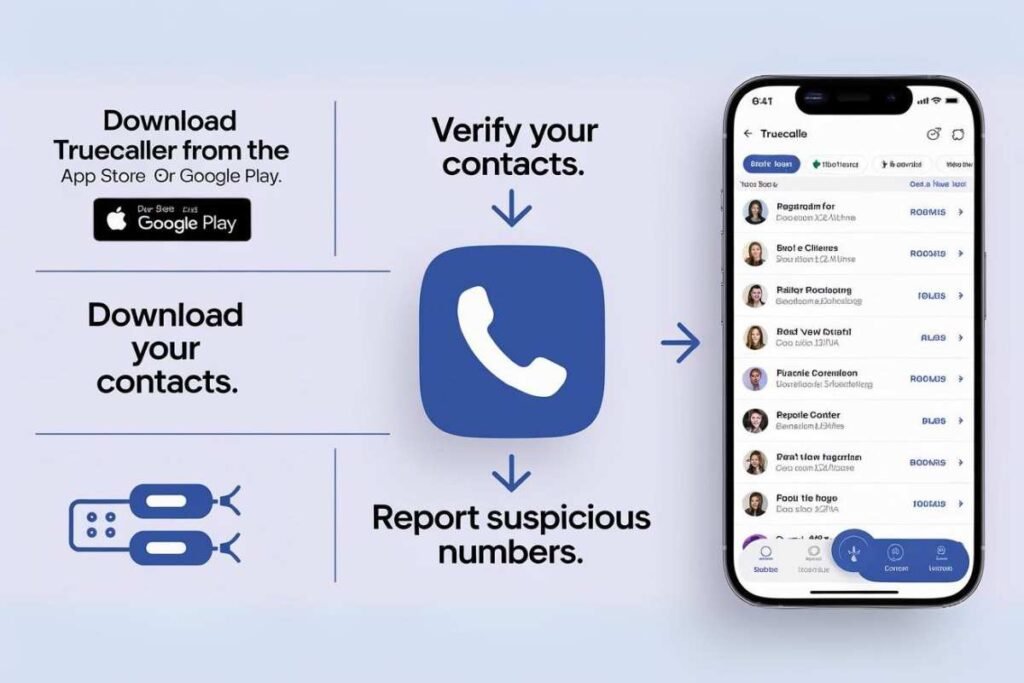Table of Contents
In today’s communication, managing calls and identifying unknown numbers is crucial due to rising spam and scam calls.
Truecallerpy, a Python wrapper, helps developers integrate Truecaller’s services into their applications for caller identification and spam blocking.
In this article, we’ll dive deep into what Truecallerpy is, how to install and use it, and what benefits it offers to developers.
What is Truecallerpy?
Truecallerpy is a Python wrapper designed to interact with the Truecaller API, enabling developers to leverage the Truecaller service within their Python applications.
A wrapper essentially “wraps” the Truecaller API in Python code, simplifying the process of using Truecaller features like caller identification, spam filtering, and number lookup in a Python environment.
For developers, using True callerpy means they don’t need to interact with raw API calls or worry about managing complex HTTP requests manually. Instead, they can focus on the functionality of their application, letting Truecalle rpy handle the behind-the-scenes work.
Why Use True callerpy?

There are several reasons why developers prefer using True callerpy in their applications:
Easy Integration
Truecallerpy simplifies the integration process of Truecaller services in Python projects.
Efficient Call Management
By using Truecaller’s robust features through True callerpy, you can easily build systems that efficiently identify spam calls and unknown numbers.
Custom Solutions
Developers can use True callerpy to build custom solutions based on Truecaller data, making it ideal for call centers, customer service teams, and businesses with large call volumes.
Open-Source
Truecallerpy is open-source, which means it is constantly evolving, with developers contributing to its improvement. This also provides the opportunity to tailor the wrapper to specific needs.
How to Install Truecallerpy
Before you can use Truecallerpy, you need to install it. The process is simple and only requires a few steps. Since Truecallerpy is available via Python’s package manager, you can install it using the following command in your terminal or command prompt:
pip install truecallerpyThis command will download and install Truecallerpy along with all its dependencies. Once installed, you’re ready to start integrating Truecaller’s functionality into your Python project.
Getting Started with Truecallerpy
Let’s walk through a basic example of how to use Truecallerpy to make a request to the Truecaller API.
Import Truecallerpy
First, you need to import the package into your Python script:from truecallerpy import search_phone_numberUsing Truecallerpy to Search for a Phone Number
Once imported, you can use the search_phone_number() function to search for a particular phone number:
phone_number = "+123456789"
result = search_phone_number(phone_number)
print(result)In this example, you pass a phone number to the search_phone_number() function, which returns details about the number, including the name of the owner (if available), whether the number is flagged as spam, and other metadata.
Key Features of True callerpy

True callerpy offers several features that make it a powerful tool for developers:
Caller Identification
Identify the caller’s name and additional details using their phone number.
Spam Filtering
Easily detect and filter spam callers using Truecaller’s large database of known spammers.
Multiple Country Support
Truecaller is available in multiple countries, and True callerpy provides support for accessing data across these regions.
Simple API
The wrapper simplifies API calls, so you don’t need to worry about complex integration or authentication processes.
How Does True callerpy Work?
True callerpy essentially acts as a middleman between your Python code and the Truecaller API. The process usually works in the following steps:
API Request
You make a request to the Truecaller API through the Python wrapper. This could be to search for a phone number or retrieve details about a specific caller.
Truecaller API
The wrapper sends the request to the Truecaller server, which processes the request and retrieves relevant information from its database.
Response Handling
The wrapper returns the data to your Python code, which you can then manipulate as needed in your application.
For instance, if you are developing a customer service tool, you can use Truecaller py to identify callers in real time and flag spam numbers automatically.
Practical Use Cases of Truecaller py
Truecaller py is an ideal tool for a variety of real-world applications. Here are some examples:
Customer Support
Integrate Truecaller py into a customer support system to provide real-time caller identification, making it easier for agents to handle inquiries.
Spam Call Prevention
Use Truecaller py to build automated systems that block spam or scam numbers before they even ring through.
Call Center Applications
For businesses that handle a large number of calls, Truecaller py can be used to filter spam and prioritize important calls, improving overall efficiency.
Telemarketing Optimization
Telemarketers can leverage Truecaller py to ensure they are targeting legitimate prospects, while avoiding numbers flagged as spam.
Limitations of True callerpy
While True callerpy offers several powerful features, there are some limitations to be aware of:
Rate Limits
Truecaller imposes rate limits on the number of API calls you can make in a specific period. Exceeding these limits may result in delays or denied requests.
Privacy Considerations
Accessing user data, even for legitimate reasons, requires a clear understanding of privacy laws and regulations. Misuse of True callerpy or Truecaller data could lead to privacy violations.
API Key
To use Truecaller py, you’ll need a valid Truecaller API key, which may require a subscription.
How to Stay Safe When Using True callerpy

To ensure that you’re using True callerpy responsibly, here are a few best practices to follow:
Respect Privacy Laws
Always comply with local and international privacy laws when using True callerpy, especially if you’re handling sensitive data.
Limit API Calls
Avoid making unnecessary API calls to reduce costs and stay within Truecaller’s rate limits.
Handle Data Securely
Store any data retrieved through True callerpy securely, and ensure you have permission to access and use the data.
Conclusion
In conclusion, Truecallerpy offers a convenient and efficient way for developers to integrate Truecaller’s powerful features into Python applications.
Whether it’s for caller identification, spam filtering, or optimizing call management systems, True callerpy simplifies the interaction with Truecaller’s API.
With easy installation, multiple use cases, and constant evolution due to its open-source nature, it’s an excellent tool for developers looking to enhance communication-related functionalities in their applications.
However, it’s crucial to adhere to privacy laws, manage API calls wisely, and ensure data security to use Truecallerpy responsibly.
FAQs
What is Truecallerpy?
Truecallerpy is a Python wrapper that simplifies interaction with the Truecaller API, enabling developers to use Truecaller’s features in their Python applications.
How do I install Truecallerpy?
You can install Truecallerpy using the command pip install truecallerpy in your terminal or command prompt.
What can I do with Truecallerpy?
Truecallerpy allows you to identify callers, filter spam numbers, and manage call data within Python applications.
Is True callerpy open-source?
Yes, True callerpy is open-source, meaning it is constantly being updated and improved by developers.
Do I need an API key to use True callerpy?
Yes, you will need a valid Truecaller API key to use True callerpy’s services.
Can True callerpy be used for spam call prevention?
Yes, True callerpy can identify and block spam calls by leveraging Truecaller’s database of known spammers.
What are the limitations of True callerpy?
True callerpy has API rate limits, requires a valid API key, and must be used responsibly to comply with privacy laws.
Is True callerpy suitable for call centers?
Yes, True callerpy can be integrated into call center systems to help with caller identification, spam filtering, and call prioritization.


